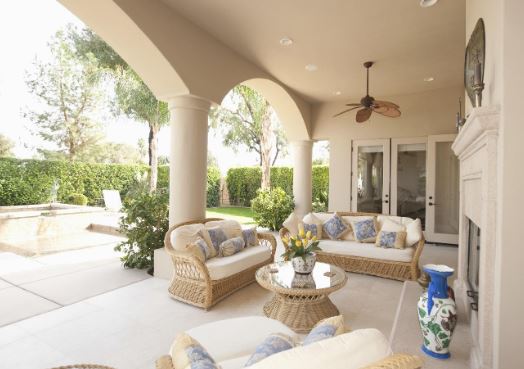Guest Post by William Turner
However, outdoor fans can often prove just as beneficial in a house new or old. Whether it’s for a patio, deck, or any other area of your house or backyard, outdoor fans provide significant utility for a variety of installations.
Efficient Cooling
Although a common patio fan may come to mind when you think of outdoor fans, the world of outdoor fans has a wide variety of designs and products to offer.
One of the biggest differences you’ll find between many fans is the length of the blades.
While most indoor ceiling fans for residential use feature blades of similar length across different products, the range in common outdoor fans is much larger.
A small patio can usually be efficiently cooled by a fan much like one you’d find in an average household room, with three to five blades of moderate length.
However, if you’re looking to cool a larger area, it might be beneficial to look into high CFM fans, which move more air and provide more intense circulation.
Fans like these might have blade spans of up to 100 inches.
Like normal indoor ceiling fans, high CFM fans can be found with only three blades, but you’ll also commonly encounter models with six to eight blades.
Don’t be deceived simply by size and amount, however.
The shaping of the blades and the power behind a fan can have as much of an impact on cooling, and you might find a reasonably small three-bladed fan with surprising efficiency.
Look into options with multiple speed settings and high specs from reputable brands to find the most power in any category.
Pest Management
Outdoor fans can help keep off unwanted pests as more powerful fans will create more intense air circulation that discourages small insects from attempting to fly into your area.
With a nice fan above your head, you can finally enjoy that cookout or family dinner without insects landing on your food left and right.
Lighting can often be a challenge for outdoor areas.
Although sunlight can work its magic during the day, you’ll need something to supplement as the evening starts to wane.
You can avoid the instability of standing light fixtures and the clutter of more overhead lights by investing in a fan with a central ceiling light.
This can open up a whole new world of usability in the evening and night hours, and effect of air circulation on pests will help counteract the issue of drawing bugs to the light that you might suffer with many other light fixtures.
Outdoor resilience
Most indoor ceiling fans would have difficulty holding up to the elements, but many outdoor fans are built to weather the storms.
If a fan is damp rated, it means it can handle the moisture of being outside on a covered patio or a similar structure. You shouldn’t have to worry about minor water damage or issues like the blades warping.
However, for a more fully exposed outdoor area, it’s best to look into wet rated fans, which are properly waterproofed to withstand rain in the environment.
Normal environmental conditions shouldn’t cause damage to the motor or tarnishing of metals with proper wet rated fans.
No matter what the purpose, an outdoor ceiling fan brings an enormous amount of value to the table.
If you’re designing or remodeling a space like a patio or porch, be sure to think about how you could naturally incorporate a fan.
You might be surprised by just how much it can transform an area!
